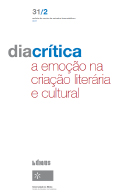Memória e emoção. Analogias e transposições poéticas na obra de Pedro Nava
DOI:
https://doi.org/10.21814/diacritica.4937Palavras-chave:
Pedro Nava, autobiografia, emoção, memóriaResumo
Este artigo oferece uma leitura do tema da emoção, centrando-se em Baú de ossos (1972), Balão cativo (1973) e Chão de Ferro (1976), de Pedro Nava. O tópico é analisado a partir do discurso memorialístico do autor, considerado em relação aos estudos de Paul John Eakin e Patrick Colm Hogan, no campo da emoção e da memória. A meta é expor como Nava combina domínios discursivos literariamente moldados pela Estética, História e Psicologia para contar histórias de vida.
Referências
ASSIS, M. (1978). Dom Casmurro. São Paulo: Abril Cultural.
BLOOM, H. (2001). O Cânone Ocidental. Rio de Janeiro: Editora Objetiva.
CAMINHA, E. (1995). Palavra de escritor (2a ed.). Brasília: Editora Thesaurus.
COHEN, P. A. (2014). History and Popular Memory: The Power of Story in Moments of Crisis (1st ed.). New York: Columbia University Press. DOI: https://doi.org/10.7312/cohe16636
CONFINO, A. (2015). Paul A. Cohen. History and Popular Memory: The Power of Story in Moments of Crisis. The American Historical Review, 120(4), 1442-1443. Oxford: Oxford University Press. DOI: https://doi.org/10.1093/ahr/120.4.1442
DAMÁSIO, A. (1996). O erro de Descartes: emoção, razão e o cérebro humano. São Paulo: Companhia das Letras.
EAKIN, P. J. (1985). Fictions in Autobiography: Studies in the Art of Self-Invention. Princeton, New Jersey: Princeton University Press.
FREADMAN, R. (2004). Decent and Indecent: Writing My Father’s Life. In P. J. Eakin (Ed.), The Ethics of Life Writing (pp. 121-46). Ithaca and London: Cornell University Press. HOGAN, P. C. (2008). Stories, Wars, and Emotions: The Absolutness of Narrative Beginnings. In B. Richardson (Ed.), Narrative Beginnings: Theories and Practices (pp. 44-62). Lincoln: University of Nebraska Press.
HOGAN, P. C. (2010). On Being Moved: Cognition and Emotion in Literature and Film. In L. Zunshine (Ed.), Introduction to Cognitive Cultural Studies (pp. 237-56). Baltimore, Maryland: The Johns Hopkins University Press.
HOGAN, P. C. (2011). What Literature Teaches Us About Emotion. Cambridge: Cambridge University Press. DOI: https://doi.org/10.1017/CBO9780511976773
NAVA, P. (1974). Baú de ossos (3a ed.). Rio de Janeiro: José Olympio Editora.
NAVA, P. (1977). Balão cativo (3a ed.). Rio de Janeiro: José Olympio Editora.
NAVA, P. (1976). Chão de ferro. Rio de Janeiro: José Olympio Editora.
PENIDO, P. (1998). Pedro Nava e O Bicho Urucutum. Entrevista de Paulo Penido a Cláudio Aguiar. In: P. Nava Pedro & P. Penido. Pedro Nava: O Bicho Urucutum (pp. 15-48). São Paulo: Ateliê Editorial/ Editora Giordano.
WEBB, E. (1992). Literature in Education: Encounter and Experience. London, New York, Philadelphia: The Falmer Press.
Downloads
Publicado
Como Citar
Edição
Secção
Licença
Direitos de Autor (c) 2023 Maria Alice Ribeiro Gabriel

Este trabalho encontra-se publicado com a Creative Commons Atribuição-NãoComercial 4.0.










